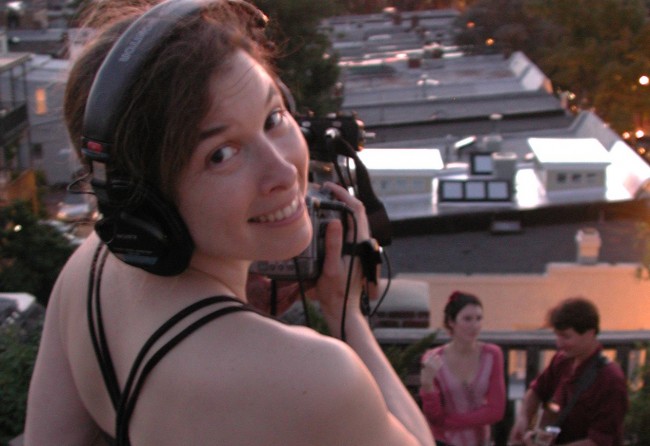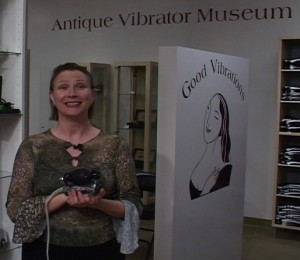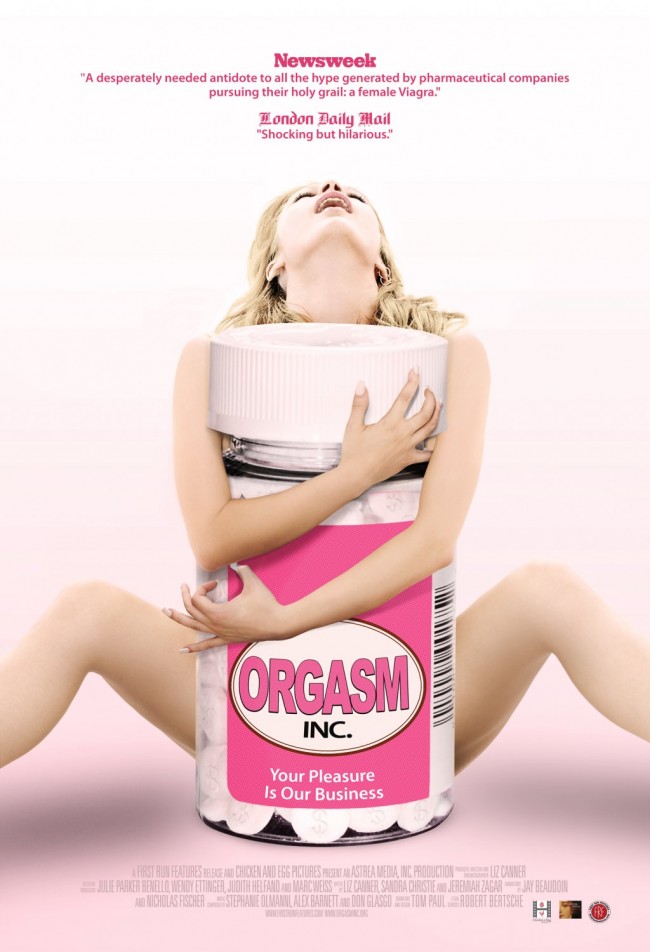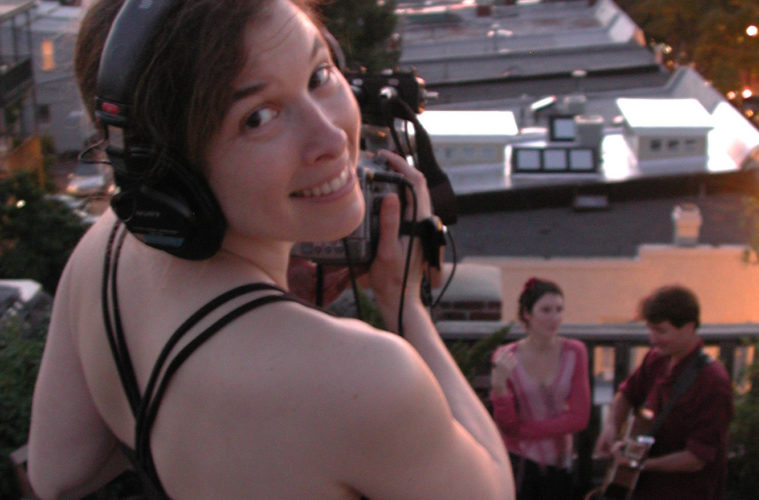
Orgasm Inc. is an exhilarating doc that takes a hard-hitting but humorous look at pharmaceutical companies’ quest to create so-called female Viagra. (Read my review here.)
Documentarian Liz Canner crafted Orgasm Inc. over a nine-year span, and provides a uniquely insider perspective, as she was employed at a pharmaceutical companies during the clinical trials for their proposed female Viagra drug. Though she set out to make a documentary about female pleasure, she found herself compelled to capture the pharma industry’s haste (and recklessness) once they began marketing an incredibly ambiguous affliction: FSD, Female Sexual Dysfunction. Before her eyes, Canner saw a disease invented and marketed to the media by the pharma companies who were racing for a quick-fix cure and its accompanying windfall.
I recently sat down with Canner and discussed her approach to Orgasm Inc., the truth behind the hype, as well as some of the film’s hairier revelations.
——-
TFS: I was pleasantly surprised by how funny Orgasm Inc. is. Despite some disturbing discoveries, it’s full of humor. How did you come upon this approach?
Liz Canner: I realized that everybody I was interviewing—for the most part—was incredibly funny. They used humor, I think because they were dealing with an uncomfortable subject. So, it reflects the tone of the people that I spoke with. Also it’s a way to make the audience feel more comfortable with something that we don’t normally talk about and that’s a little bit uncomfortable, a little bit taboo. So it’s really just a way to lighten up the subject. Although it’s an important issue, there’s also a lot we can laugh at.
In Orgasm Inc., you uncover a series of deeply troubling facts. What did you find most shocking?
I think what I found the most shocking was how uneducated we are as a population about sex, that we live in this really schizophrenic world where, on one hand, children on the average start looking at pornography at age 11, and on the other hand we teach abstinence-only in the schools. So really decent [sex] education…is not readily available, and that it makes it very easy for the medical industry to exploit us.
What was the most disturbing proposed solution for a better sex life that you found?
I found them all disturbing. I mean basically for the pills, patches, creams, the whole sort of race to create the female Viagra, the drug intervention, they haven’t come up with anything that works that well…and a lot of them have severe side effects. …and because of that, it’s disconcerting when you think that millions and millions of women could end up on these drugs that don’t really work and could potentially harm them.
I think the thing that took off the most that disturbed me in the most visceral way were the vaginal surgeries…things like collagen insertion, removal of the clitoral and vaginal canal. There’s really no good [evidence] that these medical procedures actually work [toward improving a woman’s sexual response]…And I interviewed someone who almost died of blood loss from the surgery. So, I’m very disturbed about them.
We know that there are at least 200 of these designer labia/vaginoplasty franchises, but many doctors are just doing this on their own. It’s like the wild west of surgery; they are inventing surgeries…often they’ve just made things up. There’s someone putting Botox in women’s vaginas in New Hampshire, I found someone in Albuquerque making clitorises smaller—if that’s not a clitoridectomy, I don’t know what is! And a lot of these procedures are really genital mutilation, and…It’s very upsetting that they are not being regulated, because women in a lot of cases are being sold a false bill of goods.
In the film, you talk to a rep for a vaginal cosmetic surgery company, who shows you before and after shots of women who have undergone “vaginal rejuvenation,” but won’t let you shoot these images. Did you ever consider seeking out similar images to include in the film?
I decided not to show the before and after shots, one because they are so graphic. And in a way, the audience doesn’t need to see them. But if they want to see them, they can always go online. They are very easy to find….I almost felt my responding to [the before and after shots] and the audience imagining what they look like would be just as powerful as actually showing them.
There was a little bit of a discussion about [including]…pictures of vaginas, just to show how diverse they are, as a way to sort of educate women about the fact that every vagina is very different looking. And so this idea of what a normal vagina is supposed to look like has really been fabricated. Labias come in all different sizes. We’re asymmetrical, I mean there’s no ‘one vagina’ that you’re supposed to be like.
Was this idea sidelined over MPAA concerns?
It was always a question with this documentary how far to push it in terms of the graphicness and that kind of thing. In the end, the theory was we wanted our mothers to be able to watch it and feel comfortable, because we’re all the targets of this marketing. They’re targeting older women with libido drugs; they’re targeting younger women with the surgeries. So the feeling was it had to be able to appeal to everyone. So, we decided to use humor as a way to talk about these things, and show them, but not necessarily make them graphic. So when Carol Queen talks about how if they want to make a drug [that will help women’s sex lives] they should put a map of the clitoris on the box, we show a topographical map as a way to sort of be funny and make it something you can look at [without blushing.]

Many people you interviewed in the pharmaceutical industry only spoke about female sexuality through the lens of male sexuality, to the degree that one rep laments women’s lack of a “vertical indicator.” Do you feel this contributes to their struggle to uncover worthwhile treatments for women?
I think there was this assumption early on that Viagra …was going to work on women in the same way [it does on men and] that this would improve sexual response…So I think that yeah, the initial thoughts were that men and women have the same kind of sexual responses, which I find bizarre because I’ve never met a woman that talks about how she loves getting engorged! It’s just not something that we notice or pay much attention to.
What was the goal of these proposed female Viagra?
‘Satisfying sexual event’ is the thing they always talk about as being the end point at a lot of these hearings. ‘Satisfying sexual event’ is pretty vague, and in terms of what that means…I think that the FDA has had trouble figuring out what the end point should be.
It seems that they even have trouble defining what FSD is.
Well that’s right. It seems that Female Sexual Dysfunction is a very broad disorder, and it’s sort of a misnomer because there’s nothing that says what [normal] sexual function is. There’s nothing that says you should have 10 orgasms a month to be healthy, or 20 sexual thoughts a day to have enough libido. I mean, all of this is a little bizarre because sex is a very individual thing. Sexuality is a very individual thing. So when you start trying to put it within this box, of healthy and not healthy, you run into a lot of problems. Basically that’s what they’re encountering.
Do you feel FSD is a disease?
I think that there are some real medical conditions that affect sexual experience. So if you have diabetes that can affect your sexual experience. If you have had a radical hysterectomy, that can affect libido. If you’re on anti-depressants, that can affect orgasmic function and libido. So there are some real physiological things that can affect your sexual experience. But for the most part, women who have sexual problems are totally healthy, and [their difficulties] are caused by things like past sexual abuse…stress due to overwork—there’s so many things. As we said, [it’s] lack of the good sex education that could give you ideas of what your sex life is supposed to be like. There’s a lot of different reasons that people can have not very good sexual experience: not having good communication with your partner; not having a loving partner. All of these types of things can have an impact.
 You also uncovered a strong anti-pharma culture that promotes different and less risky methods of improving women’s sex lives. How did you find them?
You also uncovered a strong anti-pharma culture that promotes different and less risky methods of improving women’s sex lives. How did you find them?
Through going to the conferences…I was going with the pharmaceutical industry and then I thought, ‘This is the other side. Finally!’
I followed them as well because this really is a battle what’s going on now, over what our sexuality should be like…I think it’s going to determine how people think about themselves and what sex means and what pleasure means in the future. That’s what I think the film is sort of documenting.
How did you decide on what would be your film’s climax?
[Part of the reason] the film took many years to make…is I was waiting for the pharmaceutical industry to get a drug approved….Every year it’d be like, ‘And the female Viagra’s coming!’ This Year—next year!’…And it finally got to the point where I said I have to end this documentary, so I ended up using the first FDA hearing of the first drug as the conclusion of the film….And in fact that was the biggest battle. We also filmed the last FDA hearing in June…and that was really not as tense. I think at the first meeting, everyone was really curious and more concerned, and some people were hoping [it’d be passed]. We were all on different sides there in terms of whether or not the drug would be approved, and they were curious of how the FDA was going to handle it….So the cinematic tension that you like to have was there at the first hearing.
How did you decide to end the film with a woman climaxing?
Well, I felt we had to deliver given the name!—No, just kidding. The reason we decided to have somebody masturbating in the film was because I think that section is really about self-love. Miriam, the woman talking, is discussing how she had a lot of body image issues and she really took time off to get to know herself, learn what she liked, and so you see her in the film—just her face really—but it sort of depicts this moment where she’s learned to love herself and have orgasms…and feel comfortable with herself. It just seemed like an important part of her story.
Did you struggle to find support for your film, as so many people seem to be ambivalent about the issue of women’s health?
I’ll tell you what I struggled with the most. There was funding out there for my film that I turned down, because the funding institutions…wanted the film to have less criticism of the pharmaceutical industry, less criticism of the vaginal surgeries. They wanted to have me tone it down, and have me interview the PR people and not just have the medical experts that I interviewed, like the CEO of a pharmaceutical company, the people during the clinical trials. They wanted me to interview the PR people.
They wanted to pay you to spin it?
Yeah! Exactly! And I believe if you have the truth–then that’s what you show! And this idea of objectivity can sometimes mask what’s really going on. So for me, I didn’t want the spin; I wanted it out of the horse’s mouth about what they were doing and that’s what I got.
So in different turns along the way there were different funders who wanted me to invest but they didn’t want me to talk about sexual abuse, so I didn’t take that money. I had to be very careful to protect the film and the integrity of the film…which made it harder to make. It made it harder to finish, harder to make, put me in some debt. But I do feel like the documentary ended up being the film that I wanted to make.
To women who do suffer from a sexual difficulty, what would you like to say?

There is a lot of help out there for women who are having sexual difficulties, and I think that that’s a myth that there isn’t. There are a lot of sex therapists that are very skilled at helping women. There are sex coaches that can help women. Betty Dodson, for instance, is a sex coach; Kim Airs is a sex coach…who can help you learn how to experience pleasure better. There are lots of female-oriented sex stores like Good Vibrations, Grand Opening—that’s online—there’s Babeland in New York. They are all over the country. A lot of women that work there have lots of good suggestions and they often have classes you can take…vibrators have shown to help many many women. Often is just takes longer for women to respond and have an orgasm than men, so it’s just taking that extra time and having that extra sensation that can make a big difference. I think there are a lot of things that work that don’t require medical intervention…Oh! The other thing I want to mention is genital massage. That’s a really really good way for women who have sexual problems to relax and have orgasms.
What would you like to say to men who may feel this doc has nothing to do with them?
Some programmers thought that only women would show up to see the film, but it turns out a lot of men are interested in female orgasms too!…Quite a few of the screenings are 50/50, and sometimes if there’s an elderly population, we’ll get a lot of older men, and they are the first to show up. So, I would say this film appeals to everyone that’s interested in this, which is a lot of the population.
What do you plan to do next?
Well, I finally think I’m going to get to the film on pleasure that I had meant to make a long time ago. I didn’t want to make a big expose, but this is what happened. So now I’m going to back and make a documentary on female pleasure.
Thanks, Liz. It’s been a pleasure.
Orgasm Inc. opens February 11th. See the trailer here.

